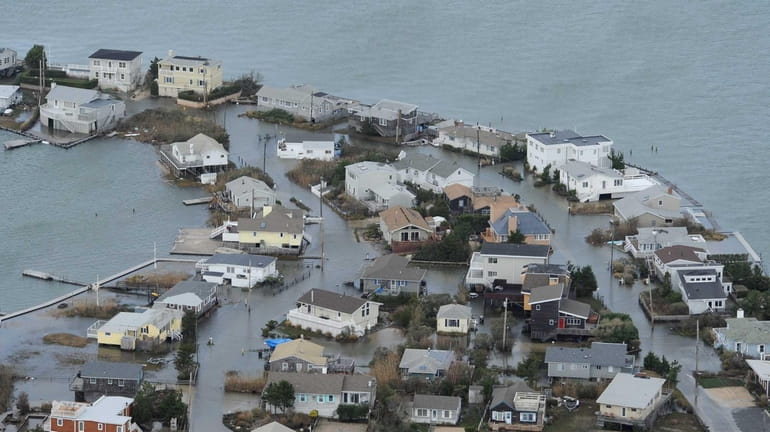Federal plan to protect Suffolk shore from storms draws skeptics
The revised federal plan to help Suffolk’s South Shore withstand nor’easters and hurricanes presented at a Wednesday night meeting in Islip — a community hit hard by superstorm Sandy — met with skepticism from islanders over its cost, advisability and effectiveness.
“I’m concerned it’ll be a waste of money and not a solution,” said George Simms, 58, of Oakdale, told federal and state officials at the public forum.
Islip is one of the Island’s coastal communities whose fragility was revealed in 2012 by superstorm Sandy, which ravaged homes, trees, power lines, marinas and docks.
The Army Corps’ Fire Island to Montauk Point project would spend around $1.2 billion, mainly on raising or flood-proofing about 4,400 South Shore homes, provided their owners have not already received federal assistance to do so.
The federal funds also would pay for recreating dunes and wetlands and elevating six miles of roads, turning them into dikes.
Marshall Brown, 57, of Sayville, questioned whether the federal plan would soon be outdated due to the rapid changes to the environment.
“How can this grand plan for 50 years to come have any validity given how quickly things are changing?”
Brown noted both Smith Point County Park and downtown Montauk lost sand in post tropical cyclone Hermine.
Lynn Bocamazo, chief, Hurricane Sandy engineering branch, New York district, Army Corps, expressed confidence in the agency’s forecasting, noting that extensive storm modeling by the agency 18 months ago reconfirmed its initial analyis from a decade ago.
She also said the county park survived a wash over and Hermine only uncovered a few of the thousands of sand bags the corps had placed in Montauk. The Army Corps is spending $207 million to build dunes on Fire Island as an interim program.
Andrew Netter, 29, of Bay Shore, asked why the government keeps pouring sand onto beaches when it continually washes away.
“This doesn’t seem sustainable . . . I don’t agree this is the solution,” he said. “The budget seems incredible.”
The high cost of sand dunes is justified because about 10 years ago, the Army Corps estimated that as an alternative, it would “probably” cost $2.5 billion to buy out the front row of oceanfront Fire Island homes, said Stephen Couch, chief, hurricane Sandy planning branch, New York district, Army Corps.
The sand replenishment cycle will last only 30 years — the length of a typical mortgage, instead of the Army Corps’ standard of 50 years, said Sue McCormick, chief of coastal erosion management program at the state Department of Environmental Conservation.
After that, McCormick asked, “are they [oceanfront homeowners] going to retreat as their beach retreats? Because the government’s not going to bail them out after that.”
Bocamazo added that mainland residents of low-lying areas at some point might face the same question about whether they also should move away from the coast.

Updated now Newsday travel writer Scott Vogel took the ferry over to Block Island for a weekend of fun.

Updated now Newsday travel writer Scott Vogel took the ferry over to Block Island for a weekend of fun.


